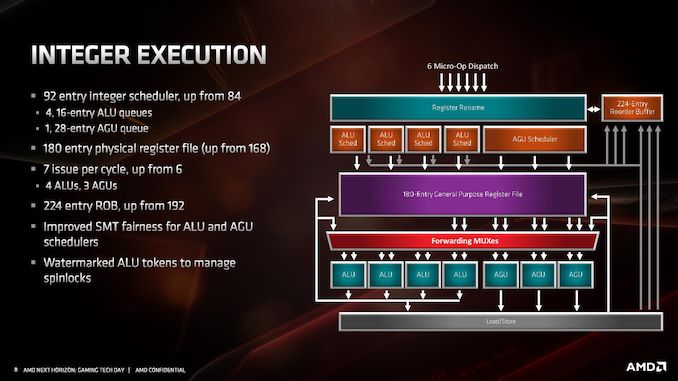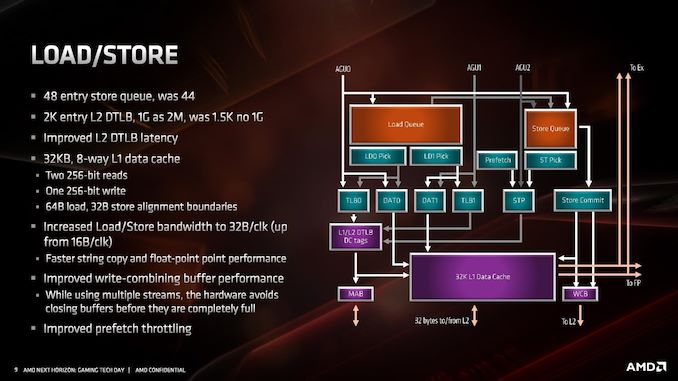AMD Zen 2 Microarchitecture Analysis: Ryzen 3000 and EPYC Rome
by Dr. Ian Cutress on June 10, 2019 7:22 PM EST- Posted in
- CPUs
- AMD
- Ryzen
- EPYC
- Infinity Fabric
- PCIe 4.0
- Zen 2
- Rome
- Ryzen 3000
- Ryzen 3rd Gen
Integer Units, Load and Store
The integer unit schedulers can accept up to six micro-ops per cycle, which feed into the 224-entry reorder buffer (up from 192). The Integer unit technically has seven execution ports, comprised of four ALUs (arithmetic logic units) and three AGUs (address generation units).
The schedulers comprise of four 16-entry ALU queues and one 28-entry AGU queue, although the AGU unit can feed 3 micro-ops per cycle into the register file. The AGU queue has increased in size based on AMD’s simulations of instruction distributions in common software. These queues feed into the 180-entry general purpose register file (up from 168), but also keep track of specific ALU operations to prevent potential halting operations.
The three AGUs feed into the load/store unit that can support two 256-bit reads and one 256-bit write per cycle. Not all the three AGUs are equal, judging by the diagram above: AGU2 can only manage stores, whereas AGU0 and AGU1 can do both loads and stores.
The store queue has increased from 44 to 48 entries, and the TLBs for the data cache have also increased. The key metric here though is the load/store bandwidth, as the core can now support 32 bytes per clock, up from 16.












216 Comments
View All Comments
GreenReaper - Tuesday, June 11, 2019 - link
A lot of progress has been made. Browsers are far more multithreaded than they once were - and as web pages become more complex, that benefit can scale. Similarly, databases and rendering can scale very well over certain operations.Said scaling tends to work best for the longest operations, because they can be split up into chunks without too much overhead. The overall impact should be that there are fewer long, noticeable delays. There isn't so much progress for things that are already pretty fast - or long sequences of operations that rely on one another. (However, precomputing and prefetching can help.)
stephenbrooks - Thursday, June 13, 2019 - link
I find it surprising how they add these smallish increases onto execution width, out of order buffers, register files etc. The IPC hasn't stopped increasing, it's just slow-ish. Maybe they're fighting power and latency in those part of the core so the 2x density from a node doesn't translate fully.Santoval - Tuesday, June 11, 2019 - link
Prices should drop when the competition with Intel becomes fiercer. I don't expect that anytime soon though.. It doesn't look like Intel will manage to release Ice Lake CPUs (except apparently the -U and -Y ones they announced) this year or at all.Their 10nm+ node is still having serious issues with clocks and thermals, and the yields are much lower than TSMC's 7nm (high performance) node. So "word on the street" is that they won't release Ice Lake CPUs for desktop at all. Id est that they'll can them and release instead Tiger Lake desktop CPUs fabbed with their fixed (??) 10nm++ node variant late next year (as in Q4 2020).
piroroadkill - Wednesday, June 12, 2019 - link
You're wrong. You get more performance than Intel at a lower price. In the case of the 3950X, it's significant. To sell them cheaper would devalue an incredible product, for no reason.Targon - Thursday, June 13, 2019 - link
Ryzen 7 2700X vs. Ryzen 7 3700X. Same price, better performance. Looking at the 3800X which is $399, look at the IPC+clock speed improvements. The 3900X will obviously come at a cost, because you are getting 50% more cores for that increased price. Single threaded though....at what point do you really focus on how fast or slow a single threaded program is running in this day and age where you run dozens of processes at the same time? If you are running dozens of single threaded programs, then performance will change based on how the OS scheduler assigns them to different CPU cores.Qasar - Thursday, June 13, 2019 - link
jjj" They give us around 20% ST gains (IPC+clocks) but at a cost. " that same thing could be said about intels cpus over the last few years... how much performance increase did they give us year over year ?? all while only giving is 4 cores for the mainstream... amd's prices are just fine.. intel is the one that should be dropping their prices, some as low as the $50 you say, but most, $500 or more
Tunnah - Monday, June 10, 2019 - link
I bet now Intel is just going to completely flood ads with the title "Intel beats AMD in pure FPS tests!", because they'll get 210fps where AMD gets 200. And some people will eat it up.I'm so excited for this upgrade. Replacing a 2700K with a 3800X, where I'll not only get a doubling of cores, but clock for clock I reckon it's a 40, 50% improvement there too.
My Civ games are gonna be so zoomy now..
xrror - Monday, June 10, 2019 - link
Intel will always beat AMD ......
...
(at a price point you don't give a f*ck about) (4 digits or more)
Are you a micro-trader hardwired into the BS Stock Exchange? You think $1000+ is too much for the fully enabled processor arch you want to overclock should cost you?
Sorry, Intel doesn't have the time of day for you after 2011, after Sandy Bridge took away the ability to overclock blessed "K" skus...
oh sure, there are others. IDT and Cyrix are dead but... let me introduce you to...
AMD
xrror - Monday, June 10, 2019 - link
This isn't aimed at you Tunnah. I meant it as humor.Read my comment like some exciting infocommercial, with ... (insert commanding infomercial voice here) hehe
Makaveli - Tuesday, June 11, 2019 - link
The 2700k and the 3800X are both 8C 16T designs.